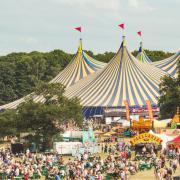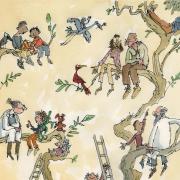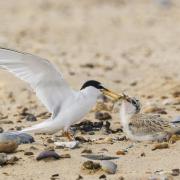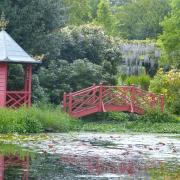Some things are just too hard, or too bizarre to explain. Like why the makers of walking boots don't use longer laces. Or how you stop sunglasses sliding down your nose when you're wearing sun cream. Far more baffling, however, is the story of the The Green Children of Woolpit.
This piece of Suffolk folklore about a pair of little green skinned children found in the west Suffolk village may have a modern explanation, but imagine what went through the minds of those 12th century villagers who chanced upon them. They must have thought they were from another world, probably not a very nice one.
Events took place during the reign of King Stephen, a particularly tumultuous time in England’s history called 'The Anarchy', between 1138 and 1153 when civil war raged in England and Normandy, leading to widespread breakdown of law and order.
In mainly peaceful Woolpit – wulf-pytt in Old English, meaning 'pit for trapping wolves' – around 1150, a group of villagers working in the fields came across two young children who mysteriously appeared near the aforementioned pits. They were dressed in strange clothes, spoke gibberish and acted somewhat nervously. And they had green skin.
According to writings at the time by Ralph of Coggeshall, the feral children were taken to the nearby home of Sir Richard de Calne. He offered them food but they refused to eat. This went on for several days until the children came across some green beans in Richard de Calne’s garden which they devoured straight out of the ground.
The children are believed to have lived with Richard de Calne for some years, surviving on harvested beans brought to them by villagers. They eventually developed a taste for bread and other foods, at which point, according to the writings of the day, the children began to lose their green complexion.
They also slowly learned to speak English. When asked where they had come from and why their skin had been green, they replied they were inhabitants of the land of St Martin, who is 'regarded with peculiar veneration in the country which gave us birth'. They claimed to be ignorant of how they arrived in Woolpit, remembering only that one day, when feeding their father’s flocks in the fields, they heard a great sound, like the chiming of St Edmund’s cathedral bells, became entranced, and suddenly found themselves among the villagers of Woolpit reaping in the fields.
'The sun does not rise upon our countrymen; our land is little cheered by its beams; we are contented with that twilight, which, among you, precedes the sun-rise, or follows the sunset,' they explained. 'Moreover, a certain luminous country is seen, not far distant from ours, and divided from it by a very considerable river.'
Richard de Calne took them to be baptised in a local church, but the boy died soon after from an unknown illness. The girl, later known as Agnes, continued to work for Richard de Calne for many years before marrying the archdeacon of Ely, Richard Barre. According to one report, they had at least one child.
So, who were the green children of Woolpit? The most likely explanation is that they were the children of Flemish immigrants who had been persecuted and possibly killed by King Stephen or King Henry II. Lost, confused and orphaned, they found their way to Woolpit speaking only their native tongue of Flemish, which seemed like gibberish to the villagers. The children’s green hue could have been due to malnourishment, or ‘green sickness’, supported by the fact that their skin reverted to normal once they began eating food other than beans.
Of course, there are other theories about the green children; they came from space or sprang from a sinister underground world. Whatever the explanation, it's a good reason for a visit to Woolpit in the month of Hallowe'en. This lovely walk, starting and finishing in the village, is about five miles of easy walking though pretty countryside, skirting the villages and hamlets of Drinkstone and Drinkstone Green.
The walk

1. Start in Woolpit. There's a village car park opposite the church, but if that's full, there is space in Rectory Lane opposite, beside the church. Head west along Church Street, towards the village centre. At the intriguing old village pump turn left and walk along Green Road, passing Mill Lane (left), reaching Drinkstone Road (right). Walk along Drinkstone Road for about 500m until you reach the last of the houses and open countryside. This is Bishop Karney Green, named after the first Bishop of Johannesburg who was Rector of Woolpit in 1903.

2. Where the footpath sign on your right directs you, take the wide green path that veers away from the road. Drinkstone mills come into view across the fields on your right, a Grade 2 listed smock mill and a Grade 1 listed post mill. The mills were worked by successive generations of the Clover family from 1775. The post mill was built in 1689, making it the oldest windmill in Suffolk, with possibly the oldest timbers in a windmill in England, some dating from 1543.
The smock mill, with its pepper pot cap, was built in 1780 on an original horse mill which had been in existence in 1689. In 1949 the post mill was badly damaged and became derelict until Wilfred Clover restored it in 1962. In 1997 the mills were sold and the sails of the post mill, which were rotting, were removed for restoration. There was a lot of fund fund raising, including a grant from English Heritage, who put the mill on the Heritage at Risk Register.
Restoration resumed in 2005. The mill was sold again in 2006, when the owners relocated to Scotland, and the current owners have been continuing repair and conservation of both mills. They're a lovely reminder of rural times past.
After about 400m, you reach a small lane. Cross over and pick up the footpath, and head gently uphill across a field towards trees.

3. Turn left onto a wooded path. This is Deadman's Lane, although why it's called that I've been unable to discover. Maybe it once lead to the local gallows; maybe it was something to do with plague. Maybe it once went through private land and was named as a warning to trespassers...
After a about 100m turn right onto a footpath and follow it around field edges, crossing timber bridges over ditches. There are more views of the mills and charming Drinkstone church. At a junction of paths turn left and stay on the path until you meet a lane.

4. Turn left. Follow the lane for about 75m to a footpath sign on your right. Take the path straight ahead. The path goes through a field and around field edges, crossing several ditches via small timber bridges.
After about a kilometre you reach a road leading to Drinkstone Green. Cross over to rejoin the path. Reaching a junction of paths, turn left, then right. The path threads its way around Garden House farm with its huge pond, opening into a field.

5. Turn left along a field edge, then at another junction of paths turn left onto a long, straight farm track, though open fields. After about a kilometre, you'll see Hill Farm ahead. Stay on the track to the left of the farmhouse, picking up a metalled road, with cottages on your left.
6. Head uphill past a farm. At a junction, ignore the road on your left and press on for about half a kilometre. You're now back on Deadman's Lane (there's no escaping!). The road bends sharp right (ignore the footpath on your left), then meets T-junction.

7. Turn left, then right along Drinkstone Road, which will take you back into the village. Woolpit is a fascinating place to while away some time. It has shops, cafes, a pub, a delightful museum (check opening times), and an elaborate village pump, installed to mark the Jubilee of Queen Victoria. Each wooden pillar carries the carved wooden effigy of a renowned British queen.
If you have time, you could seek out Lady's Well, a scheduled monument about 275m north-east of the church in a field called Palgrave’s Meadow. The small nature reserve has a natural spring, once a holy well dedicated to the Virgin Mary. It's claimed to have been a place of medieval pilgrimage with special healing properties for sore eyes. The water was analysed in the late 1970s and found to have a high sulphate content, so there could be some truth in the story.
I couldn't resist a peek inside the church. St Mary's is magnificent with a splendid porch, and a spire designed by Richard Phipson in 1870. It's a rarity in Suffolk; visible from miles around it will guide you back to the village should you get lost on your wanderings. St Mary's is one of Suffolk's Angels and Pinnacles churches and has a wonderfully restored hammerbeam roof adorned with hundreds of carved angel and human figures. It's a beauty to behold.
Compass points
Distance: 5miles/8km approx
Time: 2hours approx
Start/finish: IP30 9QP (village car park/close to Woolpit church). Accessible by bus from Stowmarket and Bury St Edmunds: suffolkonboard.com
Access: footpaths, lanes, field edges, timber sleeper ditch crossings
Map: OS Explorer 211 Bury St Edmunds & Stowmarket
Ts & Ps: Woolpit village (Teacups cafe, The Bull pub, Co-op shop). No public toilets




























